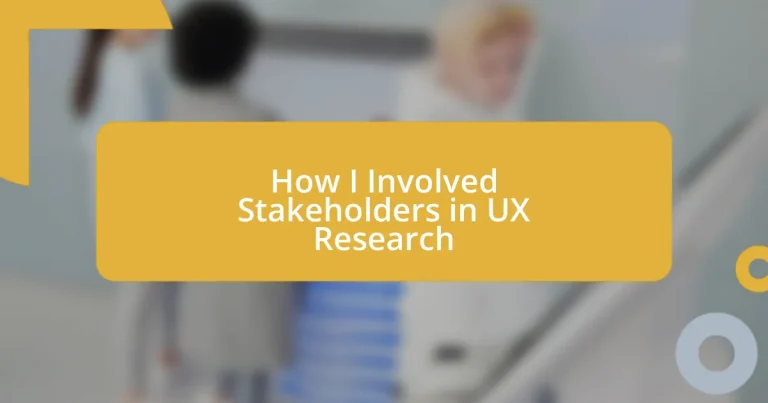Key takeaways:
- Engaging stakeholders early in the UX research process fosters collaboration and ownership, leading to richer insights.
- Establishing clear communication channels, such as shared project platforms and regular check-ins, enhances stakeholder involvement and trust.
- Involving stakeholders in research planning and co-creating methodologies can spark innovation and a sense of shared adventure.
- Gathering feedback through informal settings and analyzing it with visual tools, like affinity mapping, unveils common themes and strengthens collaboration.
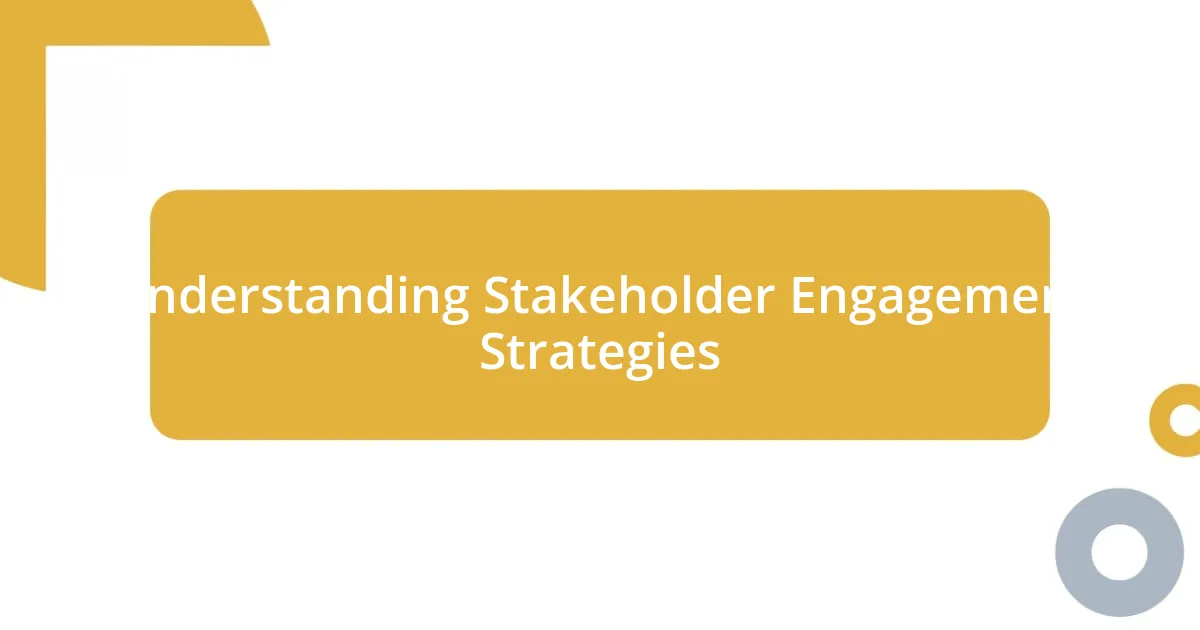
Understanding Stakeholder Engagement Strategies
Engaging stakeholders is like building a bridge; it requires understanding the foundations that support it. I remember the first time I realized the power of truly listening. During a project kickoff, one stakeholder shared a seemingly minor concern about user preferences. It turned out to be a crucial insight that shaped our entire research approach! Have you ever overlooked a small detail that ended up having a significant impact?
One effective strategy I’ve used is to involve stakeholders early in the UX research process. When I conducted a workshop to gather their input on user needs, it not only fostered buy-in but also sparked passion among them. I could see their eyes light up as they shared their experiences, transforming them from just participants into stakeholders who felt ownership of the project. Isn’t it incredible how collaboration can ignite enthusiasm and lead to richer insights?
Another approach I’ve found valuable is maintaining ongoing communication. After each research phase, I’d update stakeholders with findings in a casual yet informative way, like sharing stories over coffee. This consistency helped create trust and ensured that everyone remained aligned. When was the last time you reached out to your stakeholders with a quick update? It can make all the difference in keeping everyone engaged and informed!
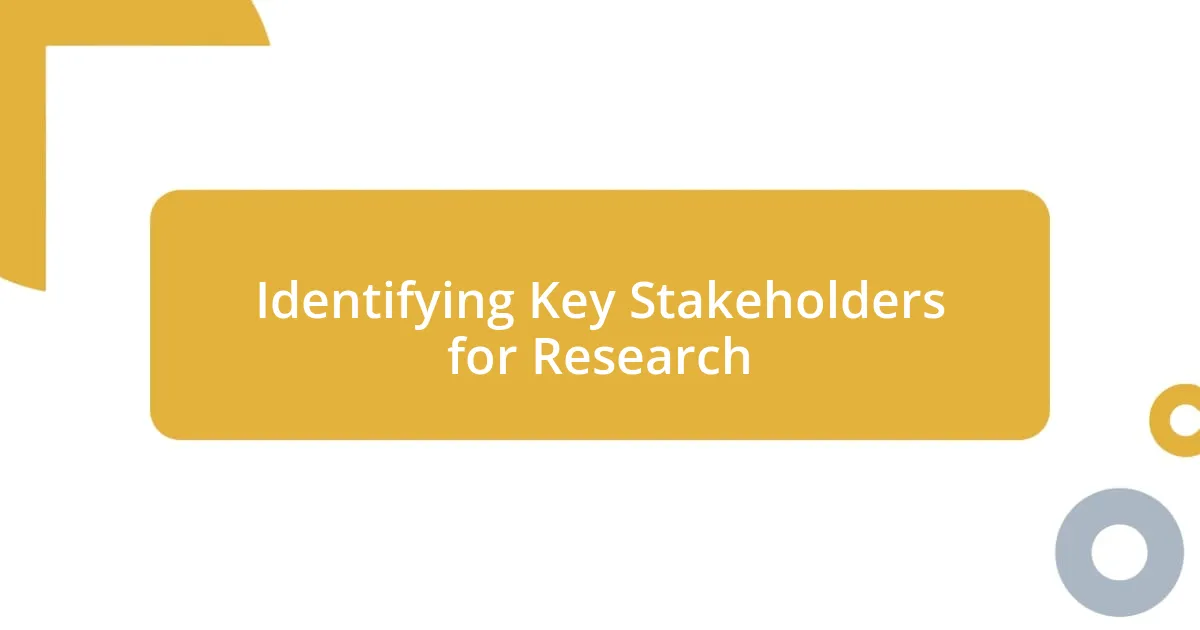
Identifying Key Stakeholders for Research
Identifying key stakeholders for your UX research can feel like piecing together a puzzle. In my experience, I’ve found that thinking deeply about who your end users are—and who influences their experience—helps narrow down the list of stakeholders. For instance, during one of my projects, I initially focused on the product managers, but soon realized that customer service representatives had invaluable insights from their direct interactions with users. It’s often those in the trenches who hold the most relevant information.
Here are some practical steps I recommend for identifying stakeholders:
- Map Out Roles: Draft a list of team members across departments and their specific roles in relation to the project.
- Evaluate Influence: Consider who has the power to make decisions or influence the direction of the project.
- Seek Diversity: Look beyond the usual suspects. Include team members from sales, marketing, and even user experience design to get a well-rounded perspective.
- Engage Early: Reach out to potential stakeholders to gauge their interest and willingness to participate in the research process.
- Utilize Networks: Don’t hesitate to ask your current stakeholders who else might be important to involve. Their insights can reveal hidden connections.
I remember when I was tasked with launching a new feature; it was the insights from a junior developer that pointed out a critical user pain point, something the senior team overlooked. True stakeholder identification isn’t just about titles; it’s about value and perspective.
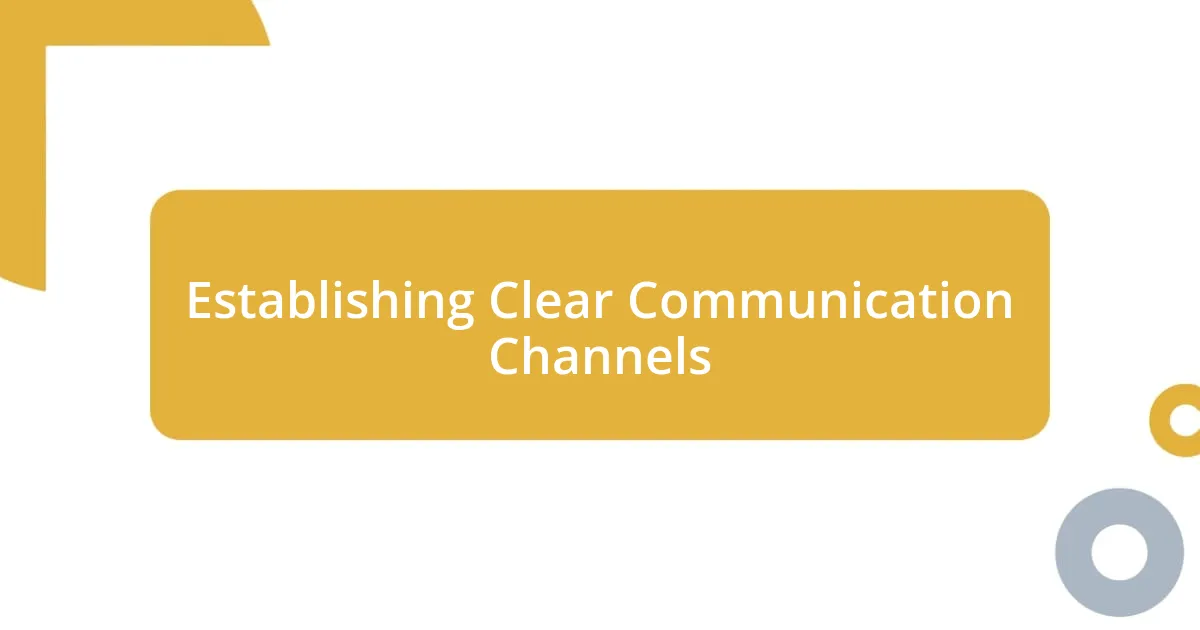
Establishing Clear Communication Channels
Establishing clear communication channels is essential for effective stakeholder involvement in UX research. One of my favorite tools to facilitate communication is a shared project management platform. In my previous project, I set up a dedicated space for stakeholders where they could effortlessly access updates, share feedback, and engage in discussions. The excitement was palpable as we exchanged ideas and refined our approaches together; everyone felt more connected to the outcome.
I also discovered that regular check-ins can transform the way stakeholders perceive their involvement. Initially, I was nervous about proposing bi-weekly meetings, fearing they might feel burdensome. However, once I initiated these sessions, I noticed firsthand how valuable they became. Stakeholders shared their insights in real-time, and it fostered a sense of camaraderie among team members. Have you ever seen relationships strengthen simply by being present and actively listening? It’s truly rewarding!
Lastly, I believe in personalizing communication based on individual stakeholder preferences. During a critical phase in one of my projects, I realized that some stakeholders preferred concise email summaries, while others thrived in detailed discussions. By customizing my approach, I ensured that everyone felt valued and well-informed. This adaptability not only bolstered trust but also enriched our research outcomes. Isn’t it refreshing to witness how a few tailored strategies can make everyone feel included?
| Communication Method | Impact |
|---|---|
| Shared Project Platform | Fosters collaboration and accessibility |
| Regular Check-Ins | Enhances real-time engagement and relationship building |
| Personalized Communication | Increases value and trust among stakeholders |
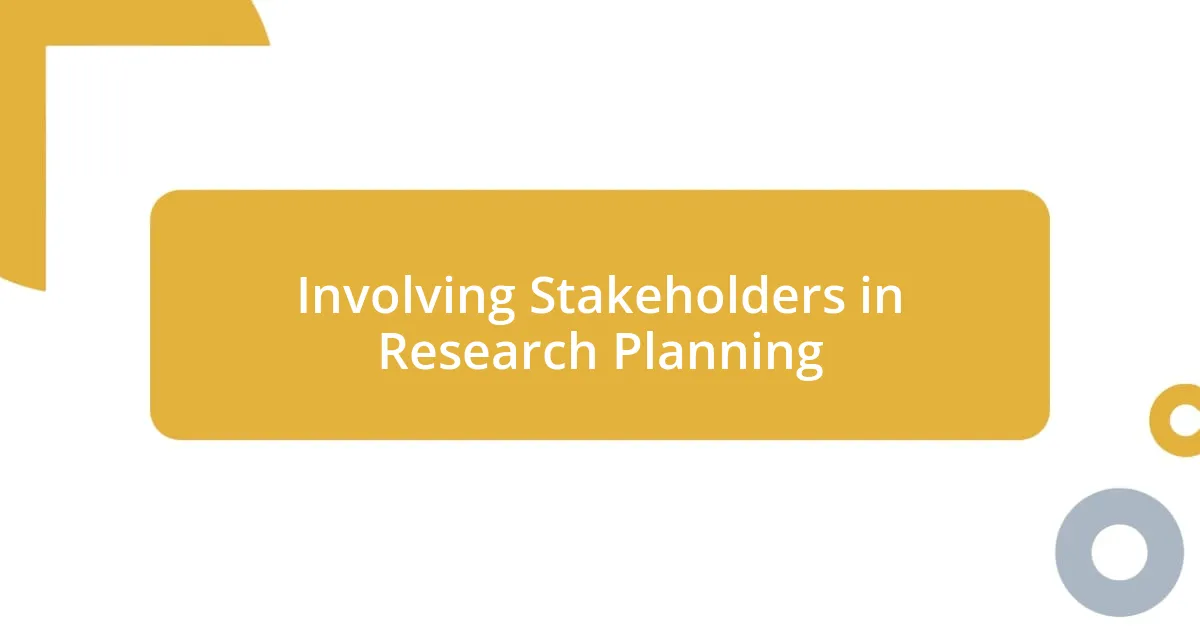
Involving Stakeholders in Research Planning
Involving stakeholders in research planning is a vital step that can shape the direction of your UX research. I always start by inviting key stakeholders to brainstorming sessions, where their input can help refine research goals. During one such session, I was surprised to find that a marketing director brought up customer personas that had slipped my mind. Their perspective during planning stages not only clarified our audience but also generated excitement about upcoming research.
When collaborating with stakeholders, I make it a point to encourage open dialogue about their expectations and concerns. For instance, I once faced a situation where a project seemed stalled because the technical team felt their feedback wasn’t considered. By establishing a platform for them to voice their insights, we uncovered a misalignment in our research questions that needed immediate attention. Have you ever felt the frustration of working without a clear directive? Addressing such feelings early on can save a lot of time and resources in the long run.
Furthermore, I believe in co-creating the research plan with stakeholders. This approach transforms them from mere participants into active contributors. In one project, I involved stakeholders in crafting our research methodologies, which led to unexpected innovations. One of the sales team members suggested incorporating live user testing, an idea that significantly enriched our understanding. That co-creation process not only enhanced buy-in but also fostered a sense of ownership among the team. Don’t you think that when stakeholders are allowed to shape the research, it feels less like a task and more like a shared adventure?
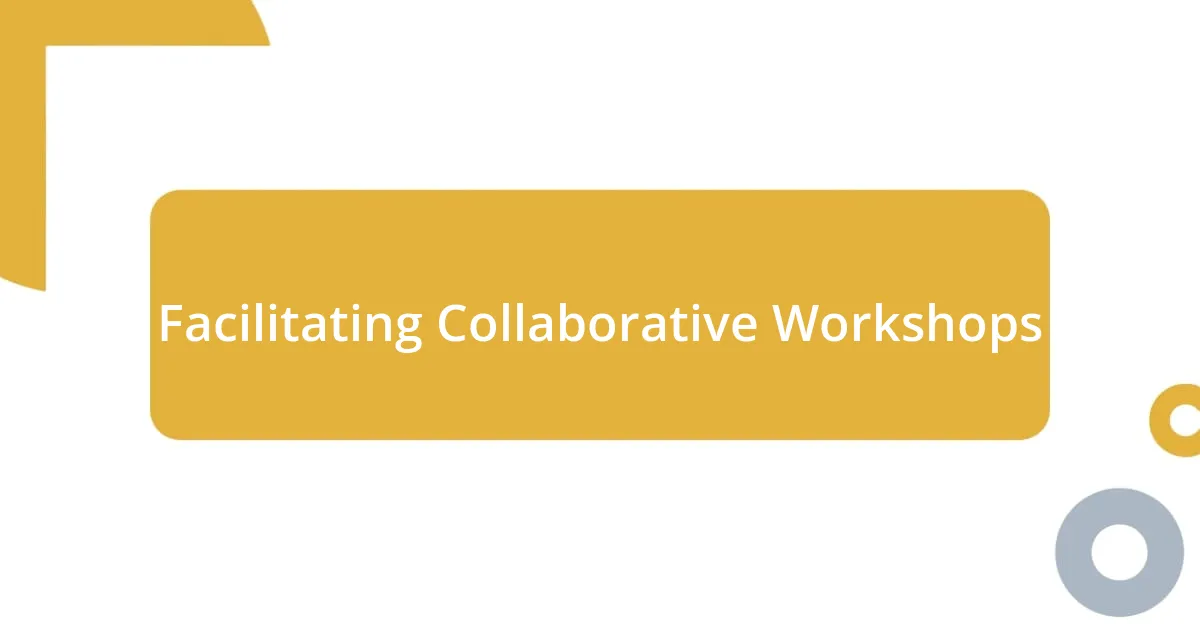
Facilitating Collaborative Workshops
Facilitating Collaborative Workshops is a powerful way to deepen stakeholder engagement during UX research. I vividly remember a workshop I organized where everyone brought their unique insights to the table. With sticky notes and colored markers, we created a visual representation of user journeys. The energy in the room was palpable! Seeing stakeholders energized by the activities boosted not only their investment in the project but also sparked some brilliant ideas that may not have surfaced in more formal settings. Who knew that a little creativity could unlock such potential?
During these workshops, it’s crucial to create a safe space for sharing ideas. I made it a point to establish ground rules that encouraged everyone to speak without fear of judgment. One time, a quiet team member shared an idea that initially seemed offbeat, but it blossomed into a key aspect of our design strategy. This experience reinforced my belief that every voice matters. Have you ever noticed how a simple change in atmosphere can lead to breakthroughs? It’s incredible how empowering individuals can lead to collective creativity.
Lastly, I always incorporate interactive activities that align with our objectives. In one workshop, we used role-playing to simulate different user scenarios, which led to eye-opening discussions about user frustrations. Witnessing stakeholders step into the users’ shoes allowed them to empathize and consider new perspectives they hadn’t previously thought about. Isn’t it fascinating how a little experimentation in a workshop can yield such rich insights? Every time I facilitate a workshop, I am reminded of the magic that happens when we collaborate and challenge each other’s thinking.
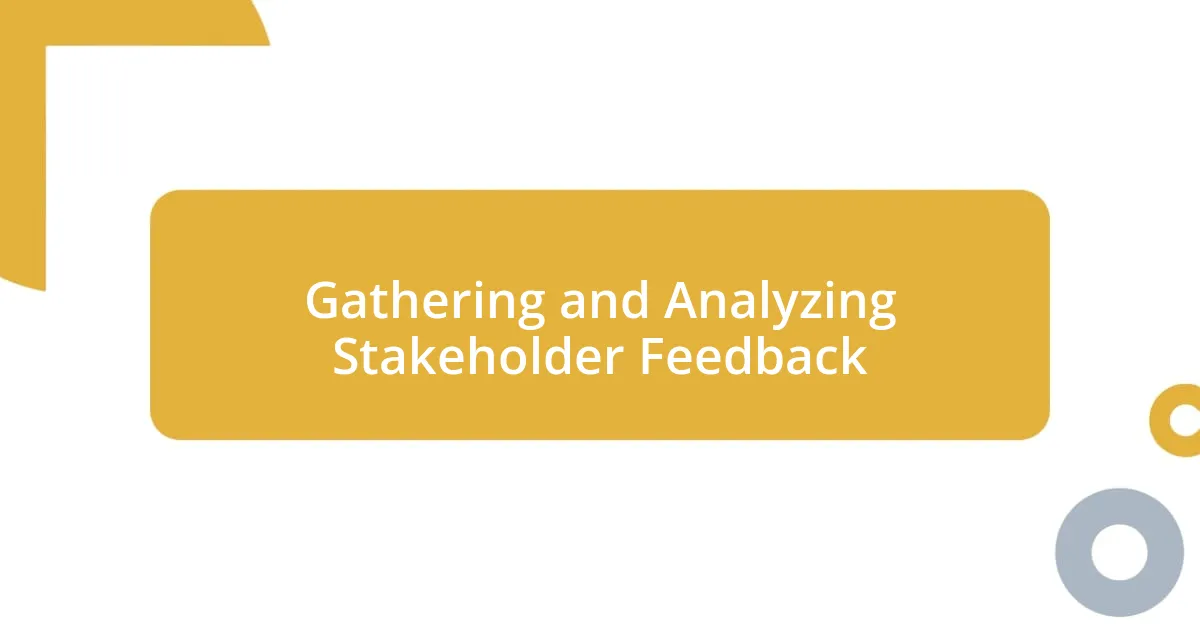
Gathering and Analyzing Stakeholder Feedback
Gathering stakeholder feedback is an essential part of understanding the needs and expectations of all parties involved. I remember a project where I conducted one-on-one interviews with stakeholders, allowing them to share their insights in a comfortable setting. This informal approach uncovered genuine concerns that would have otherwise remained hidden, making me feel more connected to the team’s vision. Have you ever realized that sometimes just listening can reveal so much?
Once I compiled the feedback, analyzing it became my next challenge. I utilized affinity mapping to categorize the insights, which visualized patterns in the stakeholders’ opinions. It was fascinating to see how different perspectives coalesced around common themes. For instance, I found that both the design and marketing teams were aligned on a desire for more user-centered features, which sparked discussions about design priorities. Isn’t it remarkable how visual tools can unveil alignment and drive discussions forward?
In my experience, following up with stakeholders after analysis is equally important. I typically summarize the key findings in a clear, concise report and share it with everyone involved. This step not only validates their contributions but also keeps the communication lines open for further dialogue. Knowing that their feedback has been valued always strengthens our collaborative spirit. How do you ensure that your stakeholders feel heard and appreciated? I’ve found that consistent follow-up fosters trust and builds lasting relationships.












